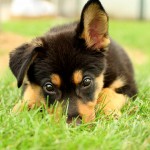Pet-Proofing Your Home

Prepare for the arrival of a new pet the way you would a small child. After all, you’re responsible for feeding and cleaning up “accidents” of a precious thing that sleeps 16 hours a day, but has the uncanny ability to seek out trouble when awake. Dogs are curious creaturesâÂ?¦ keep their noses clean.
Garbage cans cache endless delights. Not only is it a pain to clean up, strewn garbage can endanger your dog. Sharp shards and bones are choking hazards. Discarded cleanser bottles can leach into tasty waste. The acids in decomposing foods break down the lining of tin cans, leading to lead poisoning (not to mention the jagged can edge). Chocolates and bacteria-laden meat scraps are particularly toxic. Plastic bags can cause suffocation. Don’t panic! Invest in garbage bins with tight fitting lids. Add safety latches (available at the hardware store) to kitchen cabinets. Dogs don’t have opposable thumbs. Try to rinse containers thoroughly before disposing, just in case. Before leaving home, consolidate household trash to a central, secure can. Also use lidded storage bins for kibble, to keep puppy from indulging in an all-you-can eat. Add the child-proof latches to any cabinets or low drawers that contain such intriguing items as pesticides, medicines, cleansers, or candy.
Keep clutter at bay. Innocuous items like ribbons or small toys can cause choking. Bundle up electrical cords. By keeping shoes on closet shelves, you keep them out of slobbery mouths. Keep the lid to the toilet bowl closed. Though you should still scrub thoroughly, avoid sanitizing flush products if your pet has a habit of drinking from the toilet. Make sure that Fido’s bowl stays full of fresh, clear water, so he doesn’t need to seek refreshment other places.
Be aware of which plants can cause doggie distress. Though you can consult your vet for a comprehensive list, the following common plants have concerning toxicity: Anthurium, Azalea (Rhododendron), Caladium, Dumbcane, English and Japanese Yew, Eucalyptus, Hydrangea, Mistletoe, Oleander, Philodendron, Pothos, Umbrella Plant, and many varieties of lilies including Easter Lily. When in doubt, keep houseplants placed higher than those little paws can reach. Hanging baskets or wall-mounted pottery are good options.



